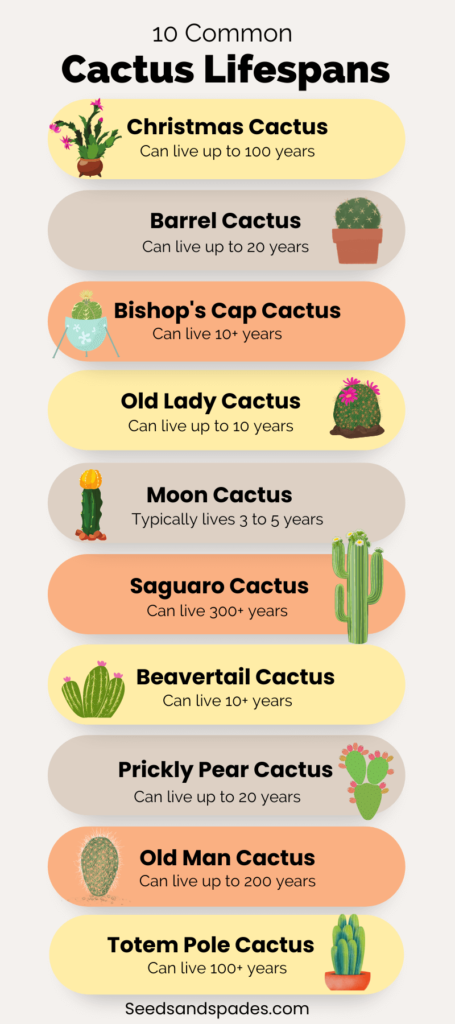Cacti are remarkable plants known for their resilience and adaptability, thriving in some of the most arid environments on Earth. Their longevity can be surprising to many. In this article, we will explore how long a cactus can live, the various factors that influence its lifespan, and the distinguishing characteristics that contribute to their enduring nature.
The lifespan of cacti varies significantly depending on the species, environmental conditions, and care practices. Some cacti can live for years, while others might endure for decades or even centuries. Understanding these aspects can help enthusiasts cultivate and maintain their cacti effectively.
Let us delve into the lifespans of different cactus varieties, giving you insights into their growth potential and longevity.
The Lifespan of Popular Cactus Varieties
Cacti exhibit an impressive range of lifespans, which can be influenced by factors such as species, habitat, and care. Here are some well-known varieties and their expected longevity:
1. Saguaro Cactus (Carnegiea gigantea)
The saguaro cactus, an icon of the American Southwest, can live for over 150 years under optimal conditions. These towering giants grow slowly, adding only about one inch in height each year during their early years. They begin to sprout arms when they reach around 50-70 years of age, further contributing to their remarkable age.
2. Golden Barrel Cactus (Echinocactus grusonii)
The golden barrel cactus can attain a lifespan of 30 to 50 years. Its round shape and striking yellow spines make it a popular choice for gardens and landscapes. While relatively shorter-lived than the saguaro, it remains a hardy and resilient plant, capable of surviving long periods without water.
3. Christmas Cactus (Schlumbergera)
Christmas cacti are known for their beautiful flowering capabilities during the holiday season. These enchanting plants can live for up to 30 years or more with proper care. Unlike traditional desert cacti, they thrive in more humid conditions and require a bit more attention to detail to ensure they do not dry out.
4. Old Man Cactus (Cephalocereus senilis)
With their distinctive tufts of white hair, old man cacti can live for more than 100 years. Native to Mexico, these enchanting succulents are slow growers, adding height incrementally over the decades. Their longevity, combined with their unique appearance, makes them highly sought after by collectors.
Factors Affecting Cactus Longevity
Understanding the elements that impact the lifespan of cacti is crucial for any enthusiast. Here are some key factors that play a role in determining how long your cactus will thrive:
Environmental Conditions
Like all living organisms, cacti are significantly influenced by their environment. Proper sunlight, temperature, and humidity levels are vital for sustaining their health. Most cacti prefer bright, indirect sunlight, while certain species can tolerate direct sunlight. Conversely, excessive shade or insufficient light can lead to stunted growth or even death.
Soil Quality
Soil plays a pivotal role in the overall health of a cactus. Well-draining soil is essential to prevent root rot, a common issue among cacti. A soil mix designed specifically for cacti or succulent plants can help ensure that excess moisture does not linger around the roots, enabling a longer lifespan.
Watering Practices
Watering is perhaps the most intricate aspect of cactus care. The general rule of thumb is to water less frequently than you might other plants, usually allowing the soil to dry out completely between waterings. Over-watering can lead to root rot and severely weaken the plant, while under-watering can cause dehydration and stress.
Routine Maintenance and Care
Regular maintenance is crucial for promoting a cactus’s longevity. This includes repotting as the cactus grows, maintaining appropriate humidity levels, and pruning any dead or unhealthy parts. Periodic fertilization with a diluted, balanced fertilizer during the growing season can also encourage healthier growth.
Signs of Aging in Cacti
As cacti reach the end of their long lives, they may exhibit signs of aging. Common symptoms include discoloration, wilting, and decreased growth rates. However, unlike some plants, cacti can often recover from adverse conditions if provided with proper care. Recognizing these signs early can enable you to take corrective measures.
Conclusion: The Timeless Appeal of Cacti
The longevity of cacti makes them unique among plants, offering the opportunity to cultivate living history. Many species can thrive for decades, provided they receive appropriate care and environmental conditions. As aspiring or seasoned cactus enthusiasts discover the fascinating world of these resilient plants, understanding their lifespan can enhance both their gardening experience and appreciation for nature.
Ultimately, cacti symbolize endurance and adaptability, making them a fitting testament to the beauty of life in even the most challenging conditions. With the right knowledge and techniques, one can welcome these hardy survivors into their homes and gardens, ensuring they thrive for generations to come.





Leave a Comment